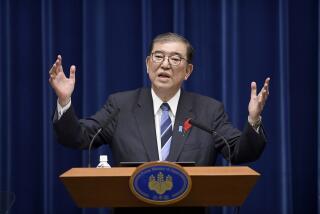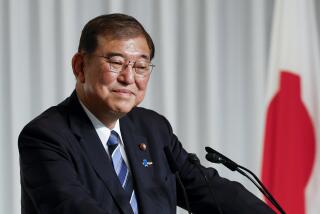Japanese Prime Minister Names His Cabinet
- Share via
TOKYO — Prime Minister Morihiro Hosokawa today appointed three women and the leaders of all six lower house parties supporting him in a coalition government to Cabinet posts.
The appointments guaranteed that the seven coalition parties, which individually support a rainbow of policies, will be in contact at the highest level at least twice a week when the Cabinet meets.
“We are setting sail for rough seas in foul weather,” Hosokawa said earlier in explaining his desire to include all coalition partners in the Cabinet. His coalition, Japan’s first since 1948, holds only a five-seat majority in the lower house.
Never before have as many as three women been named to a Cabinet. And never before has Japan had a Cabinet with as many freshman ministers.
Only Tsutomu Hata, who was named deputy prime minister and foreign minister, has served in Cabinets under the Liberal Democrats, who had ruled since 1955.
Although Hosokawa gave six of the 20 Cabinet posts to the Socialists, who oppose nuclear power generation and offer only limp tolerance of the U.S.-Japan Security Treaty, five key posts went to the Japan Renewal Party led by Hata and Ichiro Ozawa.
Hata and Ozawa bolted the Liberal Democrats in June to spur a rebellion that deprived the party of its 38-year control of the government in a July 18 election.
Three Hata-Ozawa followers were named to the Cabinet: Hirohisa Fujii, finance minister; Hiroshi Kumagaya, minister of international trade and industry, and Keisuke Nakanishi, defense agency director.
After his appointment, Hata said he wanted to carry out a foreign policy based on Japan’s own independent judgment.
Fujii declared that the 3% rate of a national consumption tax would not be raised during the Hosokawa administration and said income taxes would not be cut through deficit financing.
For the key post of chief Cabinet secretary, who coordinates the activities of the Cabinet ministries, Hosokawa turned to his close friend Masayoshi Takemura, who formed the New Party Harbinger in June after bolting the former ruling party.
Sadao Yamahana, chairman of the left-leaning Socialist Party, was named minister in charge of political reform, a new portfolio. Koshiro Ishida, head of the Buddhist-backed Komei (Clean Government) Party, was appointed director of the Management and Coordination Agency, which is in charge of administrative reform. Keigo Ouchi, chairman of the middle-of-the-road Democratic Socialist Party, was given the post of health and welfare minister. Satsuki Eda, head of the tiny Socialist Democratic Federation, became director of the Science and Technology Agency.
The three women ministers were Ryoko Akamatsu, a non-politician who is a professor at Bunkyo Women’s University and a former ambassador to Uruguay, education minister; Socialist Manae Kubota as director of the Economic Planning Agency, and Wakako Hironaka of the Komei Party as Environment Agency director.
More to Read
Sign up for Essential California
The most important California stories and recommendations in your inbox every morning.
You may occasionally receive promotional content from the Los Angeles Times.










